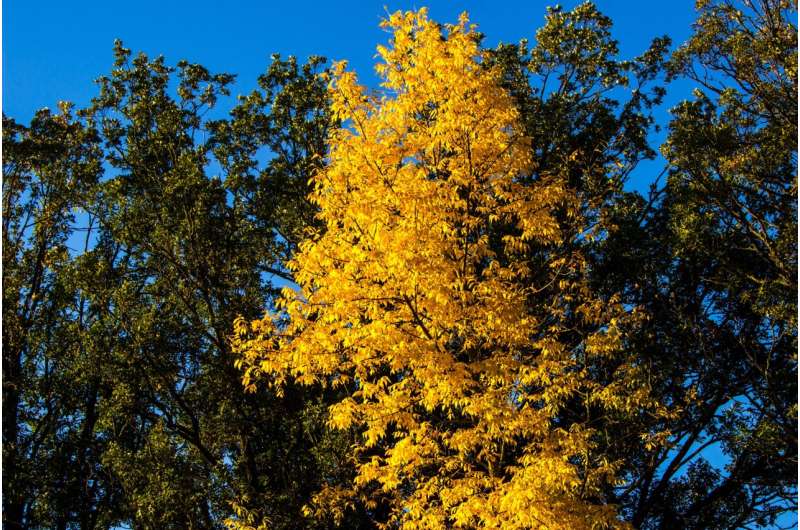Findings for invasive insect's life cycle could aid management in southeastern US

New research findings could help scientists control the emerald ash borer, an invasive pest ravaging native ash trees in North America.
In the study published in Environmental Entomology, researchers found the emerald ash borer completes its life cycle in one year in North Carolina, contrasting with the sometimes two-year life cycle that occurs in northern areas of the United States. Researchers say the findings will help researchers know when to release parasitoid wasps—a key strategy experts have used to try to manage the insect.
"This pest started off in the United States in Michigan and spread from there, so most of what we know about it in the U.S. is from a cooler climate," said the study's lead author, Ryan Bohannon, a former graduate student at North Carolina State University. "Before this study, we did not have a good understanding of what the life cycle was like in a warmer climate in the southern U.S."
The emerald ash borer, Agrilus planipennis, was first detected in the U.S. in 2002. It is now confirmed in 36 U.S. states and five provinces of Canada. The insect has been documented in more than 60 of North Carolina's 100 counties, said study co-author Kelly Oten, assistant professor and extension specialist in forestry and environmental resources at NC State.
The emerald ash borer feeds on all species of ash tree native to the U.S., which in North Carolina includes the white ash, green ash, Carolina ash and pumpkin ash. Adult beetles lay their eggs on the tree bark, and then the larvae bore into the tree and feed on the tissue inside.
Researchers have tried to release tiny wasps—some of them comparable in size to a gnat—that attack and feed on the emerald ash borer in its native range. But so far, Oten said, they haven't been able to get the wasps to establish in the warm, southern climate. The timing of the emerald ash borer's life cycle could be the key.
"If we can lower the emerald ash borer population, you might get more of your typical pest-natural enemy relationship," Oten said.
In the study, researchers collected emerald ash borer specimens from under the bark of infested ash trees in central North Carolina, brought them back to the lab, and measured them to determine their life stage. They repeated this every two weeks for 26 months. In addition, they trapped adult insects to learn more about when they are actively flying and laying eggs.
"In the stands of ash trees we studied, more than 90% of the trees were killed," said Bohannon, now a Ph.D. student at Clemson University. "There are only a few survivors. These trees are just not adapted to this insect, and the devastation is pretty striking."
They found the larvae that would be susceptible to the parasitoid wasps would be available in a distinct window in summer and early fall, from late June through October. This window is critical in understanding the best time to release the parasitoid wasps.
"This is pretty different from what we see in the northern United States, where it can take the insect two years to complete its life cycle because of colder temperatures and shorter growing seasons," Bohannon said.
In future work, the researchers plan to adjust the timing of wasp releases to match when larvae are available. They are also investigating whether to release a parasitoid wasp that lives in the southern portion of the borer's native range.
"We did a ton of work to document a detailed life cycle of this pest so that it can be directly incorporated into plans focused on biological control," Oten said. "This will likely help those efforts, especially as the pest spreads to warmer areas that have a climate like ours."
The researchers are also studying whether cutting infested trees to let them re-sprout can prolong the trees' lives, and also giving the wasps more time to establish. They have also been searching for trees that might have natural genetic resistance to the pest.
"In terms of our research on the tree side, right now, our efforts to save the tree are focused on survivors to see if any of them have natural resistance," Oten said. "But if we can get parasitoid wasps to establish in North Carolina, we might begin to be able to look at replanting for forest restoration."
More information: G Ryan Bohannon et al, Phenology and Voltinism of Emerald Ash Borer (Coleoptera: Buprestidae) in Central North Carolina, Environmental Entomology (2022). DOI: 10.1093/ee/nvac088
Provided by North Carolina State University















